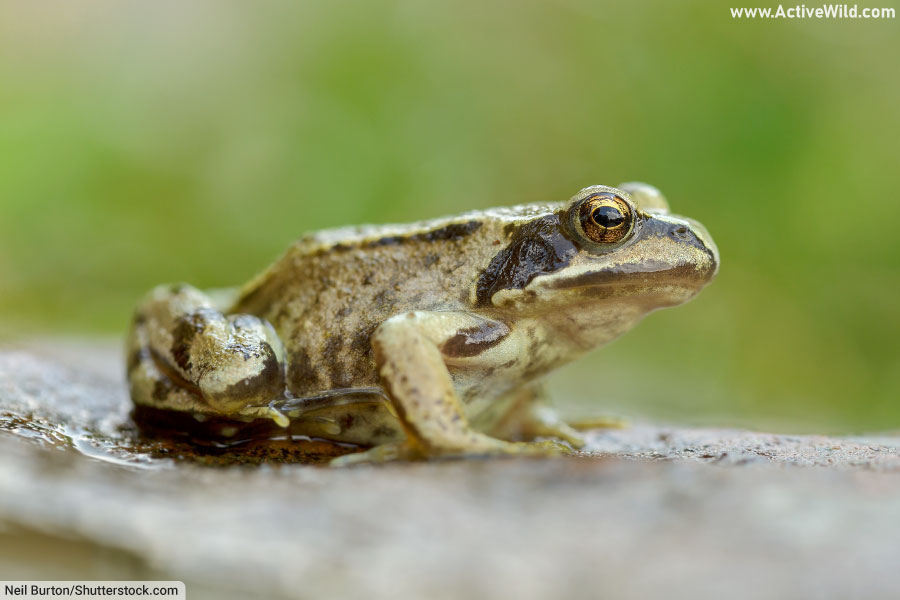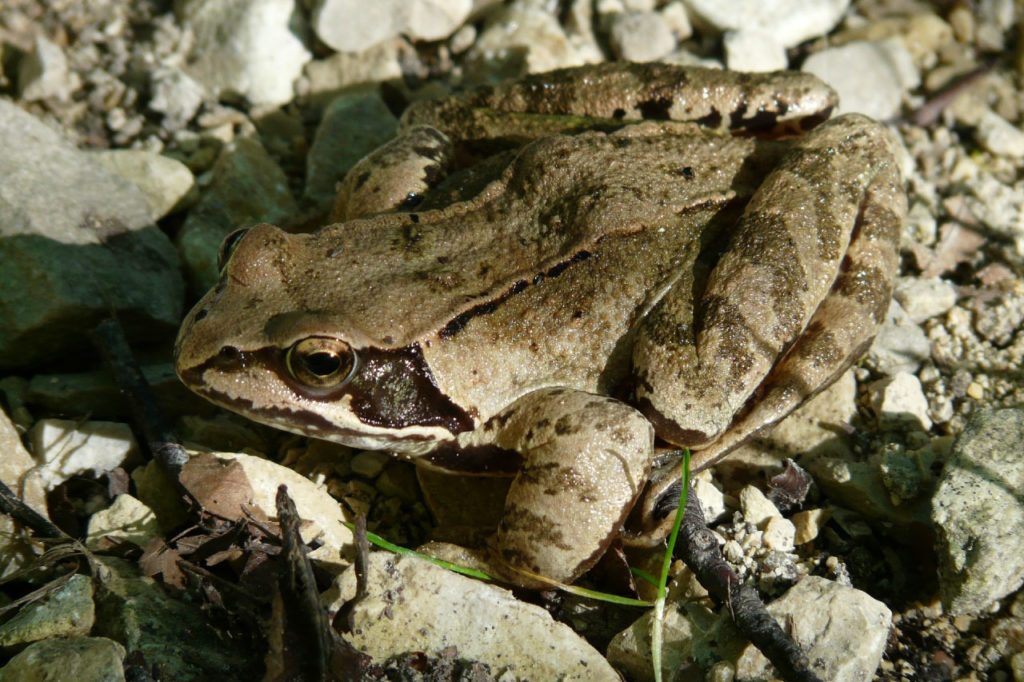Common frog facts and pictures. The common frog goes by several other names, including the European common frog and the grass frog. This familiar amphibian is often seen in or around ponds and pools in many parts of Europe. It is the only true frog native to the UK.
Common Frog Facts At A Glance
- Other Name(s): European common frog, European common brown frog, European grass frog
- Scientific name: Rana temporaria
- Type of Animal: Amphibian
- Animal Family: Ranidae
- Where Found: Europe and parts of Asia
- Length: 6 to 9 cm (2.4 to 3.5 in)
- Average Weight: 7 g (0.80 oz.)
- Conservation Status: Least Concern
- Love amphibians? See an awesome range of amphibian books at our natural history bookstore.
See awesome footage of the common frog in the video below (or scroll down for in-depth species info & pics:
Meet The European Common Frog: Introduction
The European common frog is among the most widespread and common amphibian species in Europe. It is a member of the family Ranidae, whose members are also known as the ‘true’ frogs.
The common frog is the only ‘true’ frog native to the UK. The other ‘frog’ species (i.e. members of the amphibian order Anura) in the country are toads (namely the common toad and the natterjack toad).
- You can see a list of every single British amphibian here: British Amphibians List with Pictures & Facts
What Does The Common Frog Look Like?
The common frog has a stocky body and long, powerful hind legs with webbed feet. A pair of dorsolateral folds (raised ridges of skin) extend along the length of the animal's back.
The head is wide and flat, and the snout is usually rounded. The frog's eyes are large with horizontal pupils. The tympani (ear drums) are prominent but smaller in size than the eyes.
The frog’s skin is fairly smooth and moist. The coloration is highly variable: the upper side of the body can be brown, grey, olive green, lime green, yellow or pink. Unusual variations such as black frogs and albino frogs have also been observed. The underside is usually white and the sides yellow.
The common frog can adjust its colour in order to blend in with its surroundings. During the mating season, the male turns greyish-blue and the female a deeper shade of brown or even red.
The limbs are always striped, and the back is often speckled with irregular black spots. Brown or orange blotches may cover the sides. A dark triangular patch resembling a mask extends across the eye and over the tympanum on either side of the head.
The female common frog tends to be larger than her male counterpart. Only the male frog has nuptial pads (hard swellings on the forelimbs). These are used to grasp the female while mating.
Common frog tadpoles are black when newly hatched. They soon become faintly speckled with gold or bronze.
Distribution
The common frog can be found across nearly all of Europe. Its range extends west to the British Isles, north to Scandinavia, and east to the Ural Mountains. The common frog occurs further north than any other amphibian in Europe thanks to its hardiness and ability to tolerate cold.
In southern Europe, the common frog is found from northern Spain to northern Greece. The species is absent from most of Iberia as well as from southern Italy, southern Greece and the southern Balkans.
Common Frog Habitat
The common frog is found in a wide range of habitats from sea level up to elevations of 2,700 m (8,900 ft.).
Outside of the breeding season the common frog inhabits several types of forest, tundra, meadows, grasslands, marshes, fields, parks and gardens. Adults live on land and can be found far from water.
Breeding takes place in permanent and temporary ponds, lakes, rivers, canals, ditches and puddles.
Hibernating frogs can also be found in water or in muddy burrows, compost heaps, piles of decaying leaves and under rocks.
Behaviour
The common frog is solitary for most of the year. It is most active at night and usually stays hidden during the daylight hours.
Depending on the local climate, the frog may stay active throughout most the year or hibernate for the winter months.
Frogs hibernating underwater are able to spend long periods of time without resurfacing by taking in oxygen through their skin.
Breeding
As soon as the common frog emerges from hibernation, mating takes place. This can be as early as February or as late as June. The frog tends to return to its natal pond. The males are the first to reach the breeding sites.
The males wrestle with each other and try to attract the females by producing the loudest croaks.
When the female enters the water to spawn, the male climbs on her back and grasps her with his front legs, kicking away any competitors. The frogs stay paired like this until the female has laid her eggs and the male has fertilized them with his sperm.
Each female releases roughly 1,000 to 2,000 small black jelly-coated eggs that float in large clumps close to the surface of the water.
Depending on local weather conditions, the eggs can take from 2 to 4 weeks to hatch. 10 to 15 weeks later after hatching, the tadpoles metamorphose into small froglets.
What Do Common Frogs Eat?
The common frog feeds on a wide range of invertebrates, including insects, insect larvae, slugs, snails, worms and spiders. Whereas young frogs feed both in water and on land, older frogs tend to feed only on land.
The common frog typically searches for food at night or in rainy weather during the day. It uses its long, sticky tongue to catch its prey.
Newly-hatched common frog tadpoles are mainly herbivorous. They feed primarily on algae and plants. The proportion of small invertebrates in their diet increases dramatically when the tadpoles are about to metamorphose.
Common Frog Predators
The common frog plays an important part in the food chain and has many different predators. These include birds, carnivorous mammals and snakes.
Common frog tadpoles fall prey to newts, fish, birds, dragonfly larvae and water beetles.
Is The Common Frog Endangered?
The common frog is rated 'Least Concern' by the IUCN.
The distribution range of the species is large and includes many protected areas. Generally, the animal is considered common, and there are no major threats affecting the entire population.
Localized declines have been observed in some countries, including Spain and Switzerland. These declines are a result of pollution, the disturbance of breeding sites and collection for medical research and other purposes.
Find out more about amphibians with Active Wild
- See a range of awesome amphibian books in our natural history bookstore.
- Become an amphibian expert: Amphibians: The Ultimate Guide
- Discover every single British amphibian: British Amphibians List
- Love animals? Visit this page: Animals: The Ultimate Guide to the Animal Kingdom
- See pictures and facts of incredible animals: A to Z Animals with Pictures & Facts







